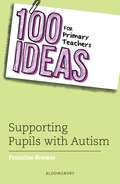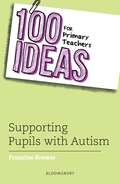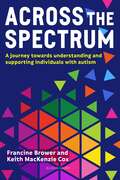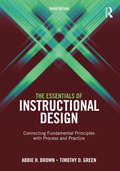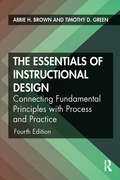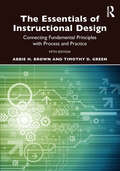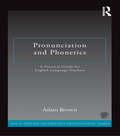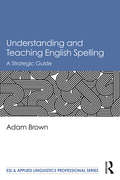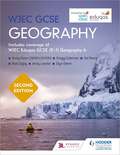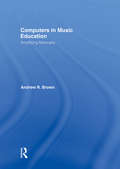- Table View
- List View
100 Ideas for Primary Teachers: Supporting Pupils with Autism (100 Ideas for Teachers)
by Francine Brower100 Ideas for Primary Teachers: Supporting Pupils with Autism is an essential resource filled with tried-and-tested ideas to best support the learning and development of pupils on the autism spectrum, in both mainstream and special schools. The reported incidence of autism has risen dramatically in recent decades and the agenda for 'inclusion' has necessitated a greater understanding of autism in primary schools. However, already stretched school budgets mean that staff are often unable to access courses for further training in this area. Francine Brower uses her extensive experience and expertise to present 100 practical ideas to enhance learning and development by focusing on the needs of the individual pupil. This dip-in-and-out book offers ways to enable teachers to better understand autism and how they can create a more supportive learning environment. There are also strategies to help children develop their communication and social skills, and become more confident and independent as individuals.
100 Ideas for Primary Teachers: Supporting Pupils with Autism (100 Ideas for Teachers)
by Francine Brower100 Ideas for Primary Teachers: Supporting Pupils with Autism is an essential resource filled with tried-and-tested ideas to best support the learning and development of pupils on the autism spectrum, in both mainstream and special schools. The reported incidence of autism has risen dramatically in recent decades and the agenda for 'inclusion' has necessitated a greater understanding of autism in primary schools. However, already stretched school budgets mean that staff are often unable to access courses for further training in this area. Francine Brower uses her extensive experience and expertise to present 100 practical ideas to enhance learning and development by focusing on the needs of the individual pupil. This dip-in-and-out book offers ways to enable teachers to better understand autism and how they can create a more supportive learning environment. There are also strategies to help children develop their communication and social skills, and become more confident and independent as individuals.
Across the Spectrum: A journey towards understanding and supporting individuals with autism
by Francine Brower Keith MacKenzie CoxAutism spectrum disorder (ASD) presents itself in many different ways, and teachers must be able to identify individual and shared characteristics to provide proper support. This can often present problems for teachers who lack experience of the entire spectrum, which ranges from supporting those with severe learning difficulties to working with highly able young people.Using real-life examples from their decades of experience, Francine Brower and Keith MacKenzie Cox explain how to identify diverse characteristics of autism, explore key challenges that individuals and schools face and offer practical, effective strategies to support pupils with ASD.Covering a range of autism characteristics, including sensory differences, communication, behaviour and socialisation, this is the ideal book for mainstream and special school teachers looking to improve their special educational needs provision, and develop the best possible learning outcomes for all pupils with ASD.
Across the Spectrum: A journey towards understanding and supporting individuals with autism
by Francine Brower Keith MacKenzie CoxAutism spectrum disorder (ASD) presents itself in many different ways, and teachers must be able to identify individual and shared characteristics to provide proper support. This can often present problems for teachers who lack experience of the entire spectrum, which ranges from supporting those with severe learning difficulties to working with highly able young people.Using real-life examples from their decades of experience, Francine Brower and Keith MacKenzie Cox explain how to identify diverse characteristics of autism, explore key challenges that individuals and schools face and offer practical, effective strategies to support pupils with ASD.Covering a range of autism characteristics, including sensory differences, communication, behaviour and socialisation, this is the ideal book for mainstream and special school teachers looking to improve their special educational needs provision, and develop the best possible learning outcomes for all pupils with ASD.
The Essentials of Instructional Design: Connecting Fundamental Principles with Process and Practice, Third Edition
by Abbie H. Brown Timothy D. GreenThe Essentials of Instructional Design, 3rd Edition introduces the essential elements of instructional design (ID) to students who are new to ID. The key procedures within the ID process—learner analysis, task analysis, needs analysis, developing goals and objectives, organizing instruction, developing instructional activities, assessing learner achievement and evaluating the success of the instructional design—are covered in complete chapters that describe and provide examples of how the procedure is accomplished using the best known instructional design models. Unlike most other ID books, The Essentials of Instructional Design provides an overview of the principles and practice of ID without placing emphasis on any one ID model. Offering the voices of instructional designers from a number of professional settings and providing real-life examples from across sectors, students learn how professional organizations put the various ID processes into practice. This introductory textbook provides students with the information they need to make informed decisions as they design and develop instruction, offering them a variety of possible approaches for each step in the ID process and clearly explaining the strengths and challenges associated with each approach.
The Essentials of Instructional Design: Connecting Fundamental Principles with Process and Practice, Third Edition
by Abbie H. Brown Timothy D. GreenThe Essentials of Instructional Design, 3rd Edition introduces the essential elements of instructional design (ID) to students who are new to ID. The key procedures within the ID process—learner analysis, task analysis, needs analysis, developing goals and objectives, organizing instruction, developing instructional activities, assessing learner achievement and evaluating the success of the instructional design—are covered in complete chapters that describe and provide examples of how the procedure is accomplished using the best known instructional design models. Unlike most other ID books, The Essentials of Instructional Design provides an overview of the principles and practice of ID without placing emphasis on any one ID model. Offering the voices of instructional designers from a number of professional settings and providing real-life examples from across sectors, students learn how professional organizations put the various ID processes into practice. This introductory textbook provides students with the information they need to make informed decisions as they design and develop instruction, offering them a variety of possible approaches for each step in the ID process and clearly explaining the strengths and challenges associated with each approach.
The Essentials of Instructional Design: Connecting Fundamental Principles with Process and Practice
by Abbie H. Brown Timothy D. GreenThe Essentials of Instructional Design, 4th Edition, introduces the fundamental elements, principles, and practice of instructional design (ID) to students new to ID. Key procedures within the ID process—learner analysis, task analysis, needs analysis, developing goals and objectives, organizing instruction, developing instructional activities, assessing learner achievement, and evaluating the success of the instructional design—are covered comprehensively and enriched with descriptions and examples of how these procedures are accomplished using the best-known models. Unlike most other ID books, The Essentials of Instructional Design provides an overview of the principles and practice of ID without placing emphasis on any one ID model. Offering the voices of instructional designers from a number of professional settings and providing real-life examples from across sectors, students learn how professional organizations put the various ID processes into practice. This revised edition features new activities, quizzes, and content on professional development. Offering a variety of possible approaches for each step in the ID process and clearly explaining the strengths and challenges associated with each, this book prepares students with the information they need to make informed decisions as they design and develop instruction.
The Essentials of Instructional Design: Connecting Fundamental Principles with Process and Practice
by Abbie H. Brown Timothy D. GreenThe Essentials of Instructional Design, 4th Edition, introduces the fundamental elements, principles, and practice of instructional design (ID) to students new to ID. Key procedures within the ID process—learner analysis, task analysis, needs analysis, developing goals and objectives, organizing instruction, developing instructional activities, assessing learner achievement, and evaluating the success of the instructional design—are covered comprehensively and enriched with descriptions and examples of how these procedures are accomplished using the best-known models. Unlike most other ID books, The Essentials of Instructional Design provides an overview of the principles and practice of ID without placing emphasis on any one ID model. Offering the voices of instructional designers from a number of professional settings and providing real-life examples from across sectors, students learn how professional organizations put the various ID processes into practice. This revised edition features new activities, quizzes, and content on professional development. Offering a variety of possible approaches for each step in the ID process and clearly explaining the strengths and challenges associated with each, this book prepares students with the information they need to make informed decisions as they design and develop instruction.
The Essentials of Instructional Design: Connecting Fundamental Principles with Process and Practice
by Abbie H. Brown Timothy D. Green• Provides an overview of the principles and practice of Instructional Design without placing emphasis on any one ID model. • Introduces the essential elements of instructional design to students who are new to ID or need a refresher while in training or professional practice. • Revised and updated to include new references, definitions, technologies, instructional formats, design approaches, and more while retaining the structure and contents of the previous edition.
The Essentials of Instructional Design: Connecting Fundamental Principles with Process and Practice
by Abbie H. Brown Timothy D. Green• Provides an overview of the principles and practice of Instructional Design without placing emphasis on any one ID model. • Introduces the essential elements of instructional design to students who are new to ID or need a refresher while in training or professional practice. • Revised and updated to include new references, definitions, technologies, instructional formats, design approaches, and more while retaining the structure and contents of the previous edition.
Activities and Exercises for Teaching English Pronunciation
by Adam BrownThis book is a practical, comprehensive tool for busy teachers or educators teaching English pronunciation. Brown puts pronunciation into perspective with other aspects of language, highlighting the importance of teaching pronunciation from the start. Applicable for both British and American pronunciation, this book is organized by aspects of pronunciation and includes a wealth of photocopiable worksheets to use in the classroom. The engaging exercises include rhymes, games, puzzles, narratives, and more, all designed to promote learner engagement and understanding. Each worksheet is accompanied by supplementary resources and guidance, including recommendations for modifying lessons for different English learner proficiency levels; instructions for the teacher and learners; correct or expected answers; and tips for teachers to extend and create their own exercises. The versatility and adaptability of this book make it a beneficial resource for teachers of ESL/EFL/EAL, as well as educational professionals who consult and oversee teacher trainer programs and courses in TESOL.
Activities and Exercises for Teaching English Pronunciation
by Adam BrownThis book is a practical, comprehensive tool for busy teachers or educators teaching English pronunciation. Brown puts pronunciation into perspective with other aspects of language, highlighting the importance of teaching pronunciation from the start. Applicable for both British and American pronunciation, this book is organized by aspects of pronunciation and includes a wealth of photocopiable worksheets to use in the classroom. The engaging exercises include rhymes, games, puzzles, narratives, and more, all designed to promote learner engagement and understanding. Each worksheet is accompanied by supplementary resources and guidance, including recommendations for modifying lessons for different English learner proficiency levels; instructions for the teacher and learners; correct or expected answers; and tips for teachers to extend and create their own exercises. The versatility and adaptability of this book make it a beneficial resource for teachers of ESL/EFL/EAL, as well as educational professionals who consult and oversee teacher trainer programs and courses in TESOL.
Pronunciation and Phonetics: A Practical Guide for English Language Teachers
by Adam BrownThis engaging, succinct text is an introduction to both phonetics and phonology as applied to the teaching of pronunciation to English language learners. Section 1 selectively covers the main areas of phonetics and phonology, without going into any area in more depth than the average English language teacher requires or that the average English language teacher trainee can handle. Section 2 focuses on practical issues related to learners and how they learn languages, and what represents good practice in terms of classroom activities for pronunciation—including aspects such as targets, motivation and priorities. The chapters end with activities to help the reader understand concepts. Section 3 provides innovative sample activities which put into practice the theoretical points covered in the first two sections, answers to the various exercises, recommended further reading (both print and non-print), a glossary of technical phonetic terms, and a bibliography of works on pronunciation teaching. The text is accompanied by a Companion Website with audio recordings of model pronunciations and audio material relating to the activities.
Pronunciation and Phonetics: A Practical Guide for English Language Teachers
by Adam BrownThis engaging, succinct text is an introduction to both phonetics and phonology as applied to the teaching of pronunciation to English language learners. Section 1 selectively covers the main areas of phonetics and phonology, without going into any area in more depth than the average English language teacher requires or that the average English language teacher trainee can handle. Section 2 focuses on practical issues related to learners and how they learn languages, and what represents good practice in terms of classroom activities for pronunciation—including aspects such as targets, motivation and priorities. The chapters end with activities to help the reader understand concepts. Section 3 provides innovative sample activities which put into practice the theoretical points covered in the first two sections, answers to the various exercises, recommended further reading (both print and non-print), a glossary of technical phonetic terms, and a bibliography of works on pronunciation teaching. The text is accompanied by a Companion Website with audio recordings of model pronunciations and audio material relating to the activities.
Understanding and Teaching English Spelling: A Strategic Guide (ESL & Applied Linguistics Professional Series)
by Adam BrownConcise and engaging, this text provides pre-service and practicing English language teachers with the knowledge they need to successfully teach the spelling of English. Offering context and explanation for the English spelling system as well as uniquely addressing specific problems in learning the spelling of English words, this book empowers readers with strategies for coping with these problems. Divided into six accessible sections, Brown covers the history of English spelling, the influence of technology on spelling, the role of punctuation, the features of present-day English spelling, teaching strategies for coping with difficult spelling, and the future of spelling and literacy. The short, digestible chapters include practical learning objectives and end-of-chapter exercises to help teachers understand and explain English spelling concepts.
Understanding and Teaching English Spelling: A Strategic Guide (ESL & Applied Linguistics Professional Series)
by Adam BrownConcise and engaging, this text provides pre-service and practicing English language teachers with the knowledge they need to successfully teach the spelling of English. Offering context and explanation for the English spelling system as well as uniquely addressing specific problems in learning the spelling of English words, this book empowers readers with strategies for coping with these problems. Divided into six accessible sections, Brown covers the history of English spelling, the influence of technology on spelling, the role of punctuation, the features of present-day English spelling, teaching strategies for coping with difficult spelling, and the future of spelling and literacy. The short, digestible chapters include practical learning objectives and end-of-chapter exercises to help teachers understand and explain English spelling concepts.
Five Teaching and Learning Myths—Debunked: A Guide for Teachers
by Adam M. Brown Althea Need KaminskeDrawing from research in developmental and educational psychology, cognitive science, and the learning sciences, Five Teaching and Learning Myths—Debunked addresses some of the most commonly misunderstood educational and cognitive concerns in teaching and learning. Multitasking, problem-solving, attention, testing, and learning styles are all integral to student achievement but, in practice, are often muddled by pervasive myths. In a straightforward, easily digestible format, this book unpacks the evidence for or against each myth, explains the issues concisely and with credible evidence, and provides busy K-12 teachers with actionable strategies for their classrooms and lesson plans.
Five Teaching and Learning Myths—Debunked: A Guide for Teachers
by Adam M. Brown Althea Need KaminskeDrawing from research in developmental and educational psychology, cognitive science, and the learning sciences, Five Teaching and Learning Myths—Debunked addresses some of the most commonly misunderstood educational and cognitive concerns in teaching and learning. Multitasking, problem-solving, attention, testing, and learning styles are all integral to student achievement but, in practice, are often muddled by pervasive myths. In a straightforward, easily digestible format, this book unpacks the evidence for or against each myth, explains the issues concisely and with credible evidence, and provides busy K-12 teachers with actionable strategies for their classrooms and lesson plans.
WJEC GCSE Geography Second Edition
by Alan Brown Bob Digby Andy Leeder Andy Owen Glyn Owen Val Davis Gregg ColemanDevelop your students' subject knowledge and skills using the second edition of the WJEC GCSE (9-1) Geography A Student book. With modernised and engaging case studies, new practice questions help students as they progress through their GCSE, providing additional opportunities to practice higher tariff exam style questions. The new Key Terms boxes provide students with concise and easy to understand definitions of key geographical terms. - Contains coherent coverage of every core and optional theme in a single volume, with clear explanations of key concepts throughout- Engages and challenges students of all abilities with an exciting, thematic approach, brought to life by Welsh, UK and international place references- Improves students' ability to interpret, analyse and evaluate geographical information through practical, skills-focused activities that involve data, maps and photographs- Boosts candidates' confidence approaching examination by providing numerous learning opportunities for each assessed theme- Enables effective differentiation with enquiry tasks designed to stretch higher-ability students and encourage independent research
Identities at Work (Technical and Vocational Education and Training: Issues, Concerns and Prospects #5)
by Alan Brown Felix Rauner Simone R. KirpalThis book examines continuity and change of identity formation processes at work under conditions of modern working processes and labor market flexibility. By bringing together perspectives from sociology, psychology, organizational management, and vocational education and training, it connects the debates of skills formation, human resources development, and careers with individual’s work commitment and professional orientations.
Respectful Research With and About Young Families: Forging Frontiers and Methodological Considerations (Palgrave Studies in Education Research Methods)
by Alice BrownThis book explores the distinctive theoretical and methodological features associated with conducting ethical and respectful research with young families, along with its unique considerations and challenges. With parents and young children understood to be both major players and ‘first educators’ in supporting childhood health, development and learning, this book examines how opportunities for research can be conceptualised within this privileged space. This volume embraces an interdisciplinary approach to this research, examining topics such as researcher identity and positioning, issues of consent, notions of power and relationships with families, methods for collecting data and frameworks for making sense of that data. Rather than providing concrete methods of practices and tools, this book will help raise the consciousness of researchers who are engaged in research with these young families. It is sure to appeal to students and scholars of education and early childhood development, as well as those concerned with conducting research ethically and respectfully.
Cautionary Tales: Strategy Lessons From Struggling Colleges
by Alice W. BrownScarcely a week goes by without a headline about the unsustainability of higher education as we know it, under threat from new models, for-profits, or online education. Most threatened are small liberal arts colleges – with commentators predicting the demise of colleges with fewer than 1,000, or even 1,500 students. Are these trends inevitable, or can they be overcome?Through a unique case study approach to examining and analyzing colleges that have struggled, Alice Brown reveals the steps that can lead to a sustainable operation and, when closure is inevitable, the steps to do so with orderliness and dignity. Rather than expounding on trends, or management theory and prescriptions, Brown focuses on narrative examples of survival and closure, recounted by real people in actual colleges, and reports the lessons they learned. Here are examples of strategies involving mergers, partnerships, or “going it alone”, and their outcomes, that illustrate principles that can serve as guides for fragile colleges struggling to address their social and economic challenges.Added to Brown’s six carefully researched and extended case studies, her own insights and analyses of decisions made and actions taken, this book offers guidance by seasoned scholars and administrators on issues as varied as leadership, the roles of the president, governing boards, faculty and staff, in articulating and implementing mission and strategies for survival, and on the changing landscape of higher education. The references to the literature on college survival strategies constitute an education in themselves.While this book is of immediate practical value for trustees and leaders of small colleges as they look toward and plan for the future and for anyone aspiring to an administrative positions in higher education, the examples constitute a microcosm of the interplay between the external constituencies, governance structures and internal forces that sustain or undermine institutional health, and which are hard to observe clearly in larger, more decentralized environments.
Cautionary Tales: Strategy Lessons From Struggling Colleges
by Alice W. BrownScarcely a week goes by without a headline about the unsustainability of higher education as we know it, under threat from new models, for-profits, or online education. Most threatened are small liberal arts colleges – with commentators predicting the demise of colleges with fewer than 1,000, or even 1,500 students. Are these trends inevitable, or can they be overcome?Through a unique case study approach to examining and analyzing colleges that have struggled, Alice Brown reveals the steps that can lead to a sustainable operation and, when closure is inevitable, the steps to do so with orderliness and dignity. Rather than expounding on trends, or management theory and prescriptions, Brown focuses on narrative examples of survival and closure, recounted by real people in actual colleges, and reports the lessons they learned. Here are examples of strategies involving mergers, partnerships, or “going it alone”, and their outcomes, that illustrate principles that can serve as guides for fragile colleges struggling to address their social and economic challenges.Added to Brown’s six carefully researched and extended case studies, her own insights and analyses of decisions made and actions taken, this book offers guidance by seasoned scholars and administrators on issues as varied as leadership, the roles of the president, governing boards, faculty and staff, in articulating and implementing mission and strategies for survival, and on the changing landscape of higher education. The references to the literature on college survival strategies constitute an education in themselves.While this book is of immediate practical value for trustees and leaders of small colleges as they look toward and plan for the future and for anyone aspiring to an administrative positions in higher education, the examples constitute a microcosm of the interplay between the external constituencies, governance structures and internal forces that sustain or undermine institutional health, and which are hard to observe clearly in larger, more decentralized environments.
Computers in Music Education: Amplifying Musicality
by Andrew BrownComputers in Music Education addresses the question of how computer technologies might best assist music education. For current and preservice music teachers and designed as a development tool, reference resource, and basic teaching text, it addresses pedagogical issues and the use of computers to aid production and presentation of students’ musical works. Written by a music educator and digital media specialist, it cuts through the jargon to present a concise, easy-to-digest overview of the field, covering: notation software MIDI sound creation downloading music posting personal MP3s for mass distribution. While there are many more technical books, few offer a comprehensive, understandable overview of the field. Computers in Music Education is an important text for the growing number of courses in this area.
Computers in Music Education: Amplifying Musicality
by Andrew BrownComputers in Music Education addresses the question of how computer technologies might best assist music education. For current and preservice music teachers and designed as a development tool, reference resource, and basic teaching text, it addresses pedagogical issues and the use of computers to aid production and presentation of students’ musical works. Written by a music educator and digital media specialist, it cuts through the jargon to present a concise, easy-to-digest overview of the field, covering: notation software MIDI sound creation downloading music posting personal MP3s for mass distribution. While there are many more technical books, few offer a comprehensive, understandable overview of the field. Computers in Music Education is an important text for the growing number of courses in this area.
